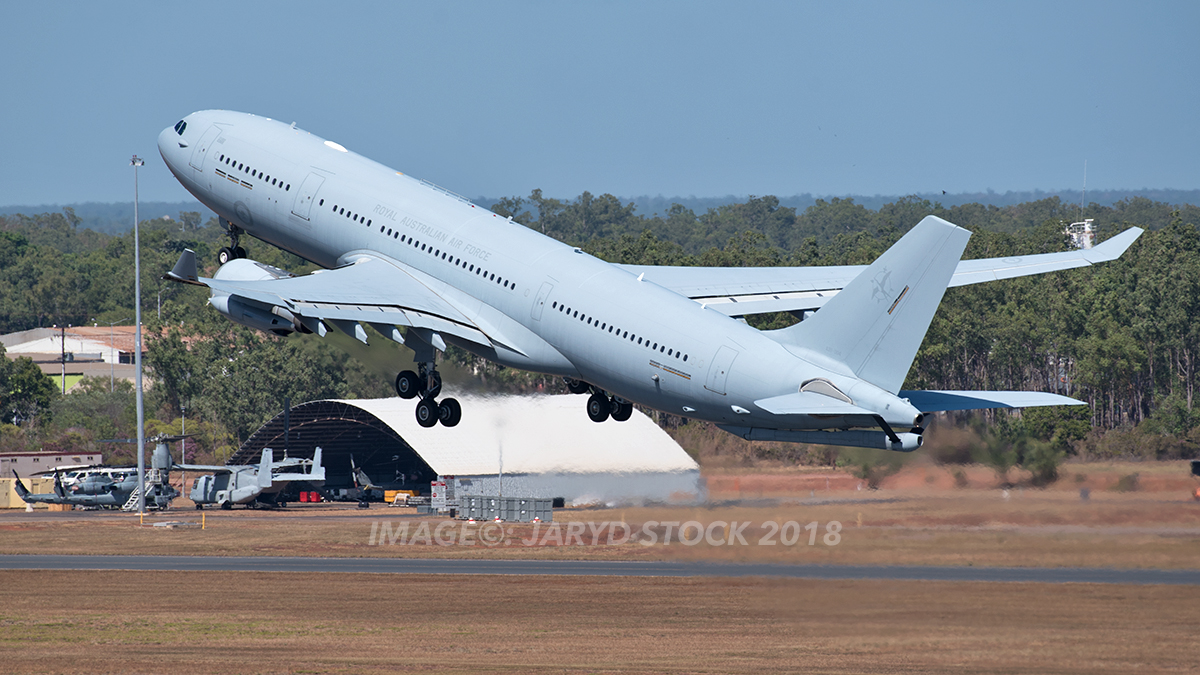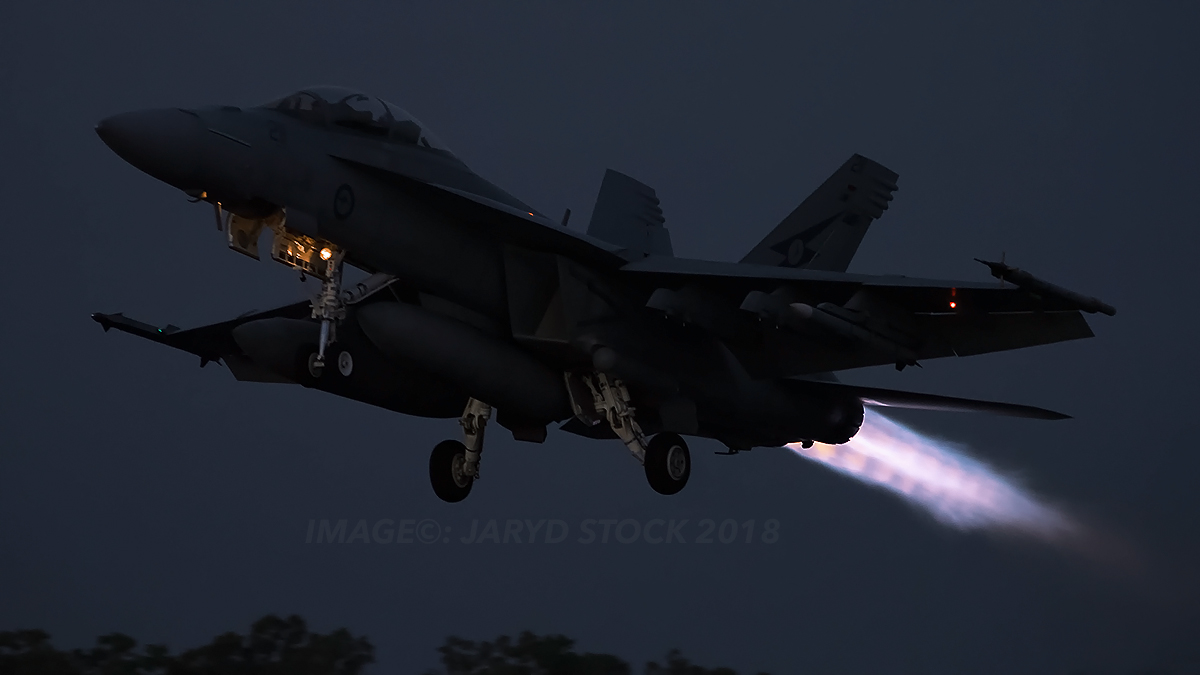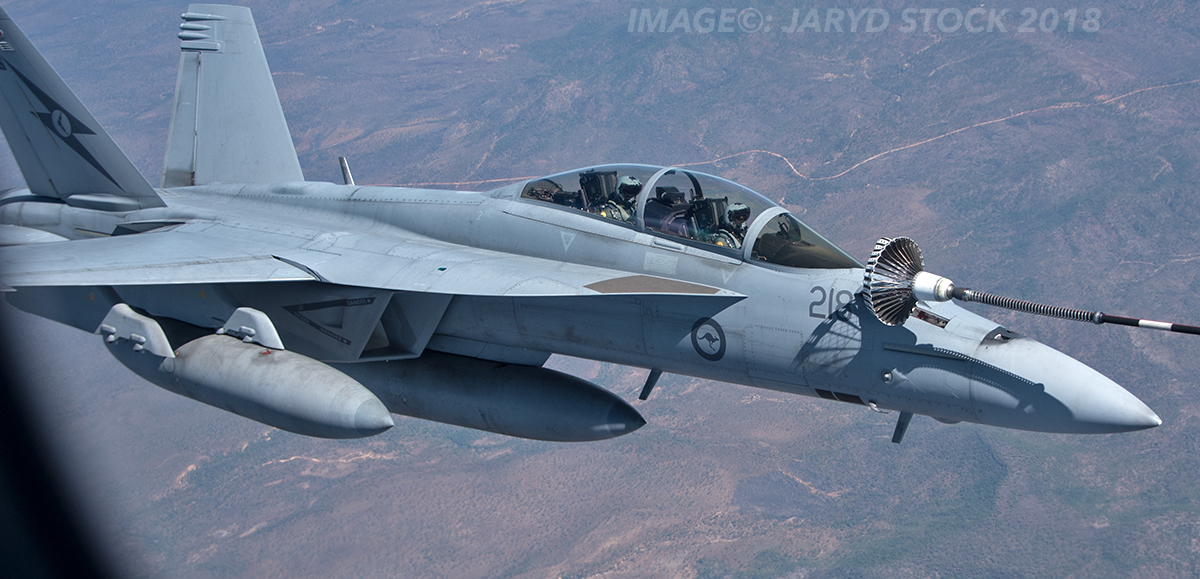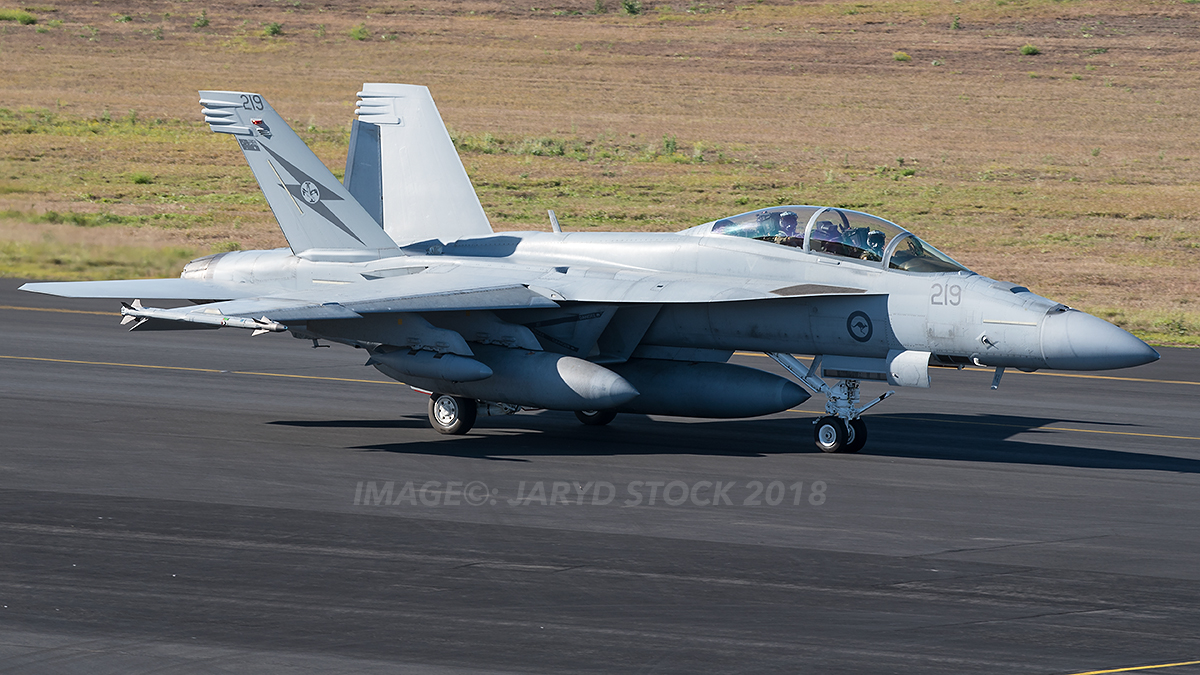RAAF’s AIR COMBAT GROUP completes strike missions for Operation OKRA
Report and photos by Jaryd Stock
January 3, 2018
Australia’s contribution to the global war on terror in part concluded officially for the Royal Australian Air Force’s Air Combat Group on the 22nd of December with six RAAF F/A-18F Super Hornets from No.1 Squadron from 82 Wing based at RAAF Base Amberley will return home in January marking the end of Australia’s successful air strike operations in Iraq and Syria.
Minister for Defence, Senator the Hon Marise Payne, said Australia had reviewed our contribution with our Iraqi and Coalition partners following the announcement of Iraq’s liberation from Daesh by Prime Minister of Iraq Haider al-Abadi earlier this month.
“The battlefield success against Daesh means our own Operation OKRA has now reached a natural transition point and our strike aircraft will begin returning home early in the New Year,” Minister Payne said.
“Since October 2014, our Super and Classic Hornet pilots and support personnel from various Squadrons including No.1 (Super Hornet), 3, 77 and 75 Squadrons (Classic Hornets/ Alpha variant) have made a significant contribution in support of the Iraqi Security Forces and I commend all the ADF personnel who have contributed over this period for their dedication, skill and professionalism.”
“Australia’s Air Task Group has made a valued contribution to coalition operations against Daesh that is highly regarded by the United States, Iraq and coalition partners.”
Back in 2014 the Australian Prime Minister at the time Tony Abbot flanked by the Defence Minister and Chief of the Australian Defence Force publicly announced that the Australian Defence Force, and in particular the Royal Australian Air Force was tasked to join a coalition of nations to stem the tide in the war against terror.
It was for the first time since 2003 the RAAF would send components of its Air Combat Group (ACG) to conduct flying combat missions, as well as being supported by other various components from Air Mobility Group (AMG) No.33 Squadron (KC-30A) supplemented by No.36 Squadron (C-17A Globemaster) and Surveillance and Response Group (SRG) No.2 Squadron (E-7A Wedgetail AEWC).
Once the announcement was made the Australian Government gave 82 Wing which acts as the Umbrella for No.1 Squadron (The Fighting First), a week for it to deploy 8 Super Hornets which were supported by several No.36 Squadron C-17A Globemasters and two No.33 Squadron KC-30A tankers, both of the latter tasked from AMG were tasked to support and enable the 82 Wing’s deployment in getting to the Middle East.
400 personnel made up the RAAF’s presence in the MEAO and on September 21, ACG’s Fighting First along with support elements from AMG and SRG left from their respective home bases for Al Minhad Air Base in the United Arab Emirates where the RAAF would call home during this opened ended air campaign.
The strike aircraft from Air Combat Group which included the F/A-18A Hornet’s and F/A-18F Super Hornet’s deployed as part of the Air Task Group conducted more than 2,700 sorties against Daesh targets in both Iraq and eastern Syria.
On September 14 2014 combat missions against ISIS targets had begun, a typical load that the Super Hornet would carry at the start of combat flying operations would be three external fuel tanks, carried on station 6 which is the centreline hard point and stations 4 and 8 which are the inboard stations, with two AIM-9X air to air missiles on both 1 and 11 stations (wingtip hard points) also carried was a ATFLIR targeting pod usually carried on the shoulder station (intake hard points) of the aircraft with a AIM-120C AMRAAM air to air missile on the opposite shoulder station.
The Ordnance used on ground targets would usually consist of 2-4 240kg GBU-12 laser guided and GBU-38 GPS guided precision bombs, even though ISIS wasn’t considered a threat in the air, the air to air missiles have little effect on drag and thus were a smart insurance policy. The various Squadrons would usually rotate between the other Squadrons on a 6 month deployment rotation throughout the two and a bit years conducting Strike Operations during OKRA.
Fittingly it was No.1 Squadron that would finish what was started back in 2014 with it being the last Air Combat Group Squadron deployed to the Middle East before flying combat operations ceased.
Royal Australian Air Force’s No.2 Squadron’s E-7A Wedgetail and No.33 Squadrons KC-30A refuelling aircraft will continue to support counter-Daesh coalition operations conducting command and control and Aerial Refuelling respectively Australia will also continue its training mission, which involves around 300 personnel at Task Group Taji and around 80 personnel in a Special Operations Task Group.
“Australia is committed to supporting the Iraqi Security Forces as it clears the remaining pockets of Daesh fighters in rural areas and ensuring the long-term stability of Iraq,” Defence Minister Payne said concluding the media briefing.
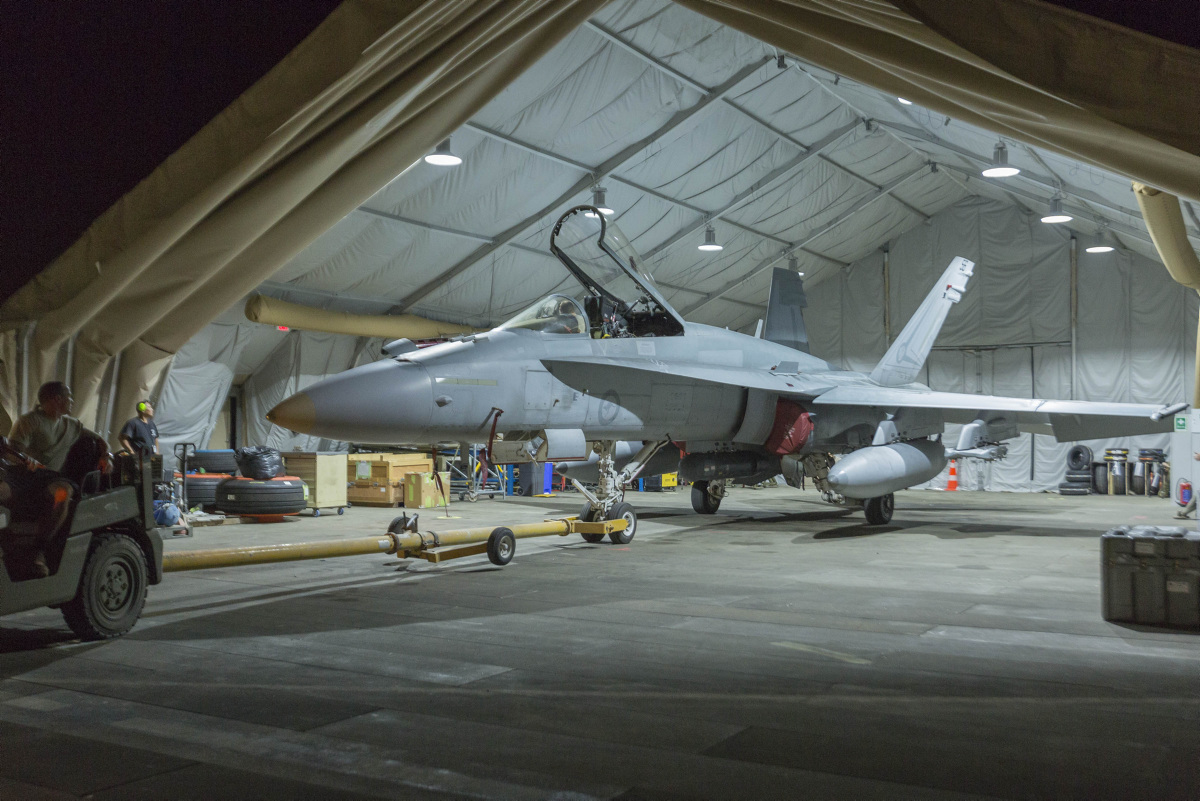
Maintenance Personnel from the Air Task Group 630 Strike Element tow an F/A-18A Hornet in to the 4K Hangar at Australia’s main air operating base in the Middle East Region. *** Local Caption *** Maintenance personnel with Air Task Group 630 are able to escape the heat and distraction on the flightline at Australias main air operations base in the Middle East. A 4K Hangar so named because it covers an area of 4000 square feet has been constructed to allow maintenance on F/A-18 Hornets deployed for Operation Okra. The hangar was constructed by Joint Task Force 633s Combat Support Unit, and Airfield Engineers from No. 65 Squadron.
The Air Task Group (ATG) of Operation OKRA, is operating at the request of the Iraqi Government within a US-led international coalition assembled to disrupt and degrade Daesh operations in the Middle East Region (MER). The ATG comprises six RAAF F/A-18A Hornet fighter aircraft, an E-7A Wedgetail airborne command and control aircraft, and a KC-30A Multi-Role Tanker Transport air-to-air refuelling aircraft. Additionally, the ATG has personnel working in the Combined Air and Space Operations Centre, and embedded with the Kingpin US tactical Command and Control Unit.
The ATG is directly supported by elements of Operation ACCORDION including the Theatre Communications Group, Air Mobility Task Group, and the Combat Support Unit, whose mission is to provide airbase and aviation operational support to sustain air operations in the MER. There are up to 350 personnel deployed, at any one time, as part of, or in direct support of the ATG. © Commonwealth of Australia, Department of Defence

Royal Australian Air Force Ground Liaison Officer Flight Lieutenant Daniel Gusthart (left) and a pilot from the Air Task Group, hold an Australian National Flag prior to it being flown in the cockpit of an Operation OKRA mission out of the main air operating base in the Middle East. *** Local Caption *** The Air Task Group (ATG) of Operation OKRA, is operating at the request of the Iraqi Government within a US-led international coalition assembled to disrupt and degrade Daesh operations in the Middle East Region (MER). The ATG comprises seven RAAF F/A-18A Hornet fighter aircraft, an E-7A Wedgetail airborne command and control aircraft, and a KC-30A Multi-Role Tanker Transport air-to-air refuelling aircraft. Additionally, the ATG has personnel working in the Combined Air and Space Operations Centre, and embedded with the Kingpin US tactical Command and Control Unit.
The ATG is directly supported by elements of Operation ACCORDION including the Theatre Communications Group, Air Mobility Task Group, and the Expeditionary Airbase Operations Unit, whose mission is to provide airbase and aviation operational support to sustain air operations in the MER. There are up to 350 personnel deployed, at any one time, as part of, or in direct support of the ATG. © Commonwealth of Australia, Department of Defence
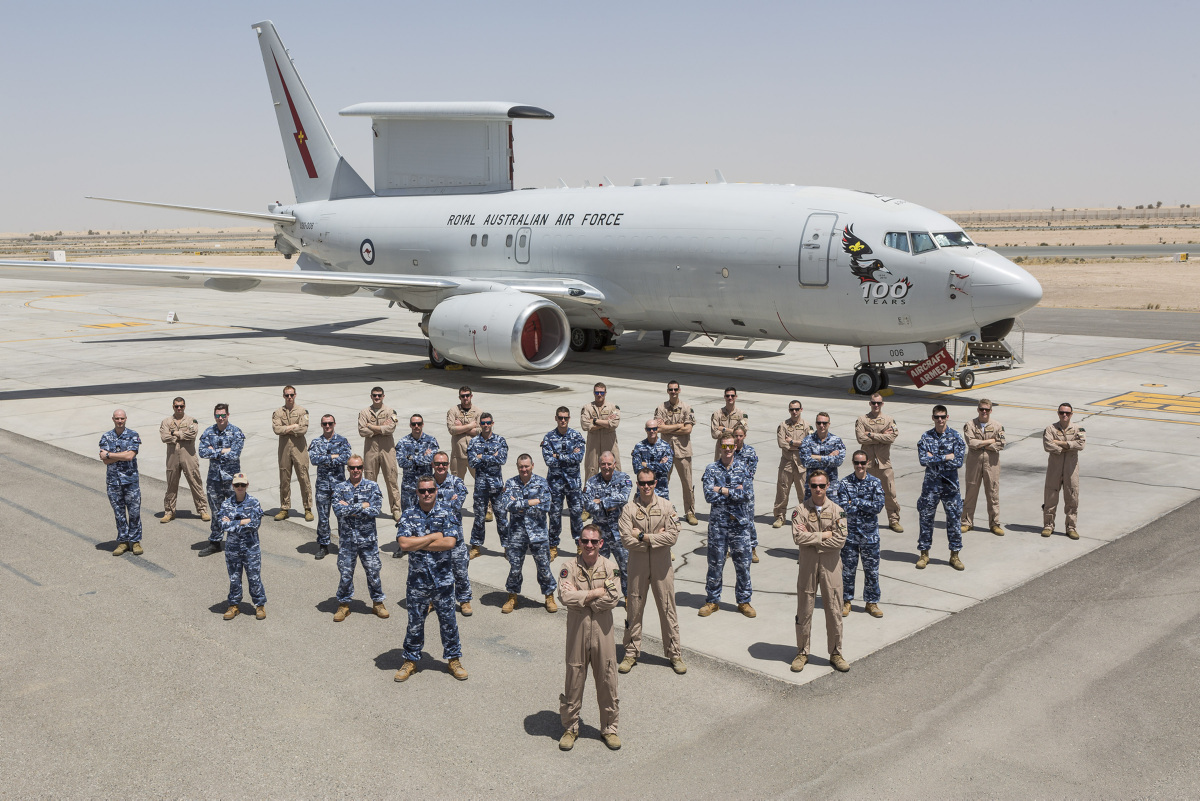
Royal Australian Air Force personnel from the Air Task Group Task Element 630.1.2, Rotation 11, stand before an E-7A Wedgetail airborne command and control aircraft at the start of their deployment to the main logistics base in the Middle East Region. *** Local Caption *** The Air Task Group (ATG) of Operation OKRA, is operating at the request of the Iraqi Government within a US-led international coalition assembled to disrupt and degrade Daesh operations in the Middle East Region (MER). The ATG comprises six F/A-18F Super Hornet fighter aircraft, an E-7A Wedgetail airborne command and control aircraft, and a KC-30A Multi-Role Tanker Transport air-to-air refuelling aircraft. Additionally, the ATG has personnel working in the Combined Air and Space Operations Centre, and embedded with the Kingpin US tactical Command and Control Unit.
The ATG is directly supported by elements of Operation ACCORDION including the Theatre Communications Group, Air Mobility Task Group, and the Expeditionary Airbase Operations Unit, whose mission is to provide airbase and aviation operational support to sustain air operations in the MER. There are up to 300 personnel deployed at any one time to the Air Task Group, with an additional 100 personnel deployed in direct support of Operation OKRA. © Commonwealth of Australia, Department of Defence

Royal Australian Air Force Aircraft Structural Technician Corporal David Wilson, from the Air Task Group, grinds the edges of a carbon fibre composite mould for an aircraft repair, during his Operation OKRA deployment at the main air operating base in the Middle East Region. *** Local Caption *** The Air Task Group (ATG) of Operation OKRA, is operating at the request of the Iraqi Government within a US-led international coalition assembled to disrupt and degrade Daesh operations in the Middle East Region (MER). The ATG comprises six F/A-18F Super Hornet fighter aircraft, an E-7A Wedgetail airborne command and control aircraft, and a KC-30A Multi-Role Tanker Transport air-to-air refuelling aircraft. Additionally, the ATG has personnel working in the Combined Air and Space Operations Centre, and embedded with the Kingpin US tactical Command and Control Unit.
The ATG is directly supported by elements of Operation ACCORDION including the Theatre Communications Group, Air Mobility Task Group, and the Expeditionary Airbase Operations Unit, whose mission is to provide airbase and aviation operational support to sustain air operations in the MER. There are up to 300 personnel deployed at any one time to the Air Task Group, with an additional 100 personnel deployed in direct support of Operation OKRA. © Commonwealth of Australia, Department of Defence

Royal Australian Air Force aircraft structural technicians, Corporal David Wilson (left), Sergeants Michael Hemming (centre) and Ashley Ranford visually inspect a fibre glass filler prior to repairing an F/A-18F Super Hornet aircraft at the main air operating base in the Middle East Region. *** Local Caption *** The Air Task Group (ATG) of Operation OKRA, is operating at the request of the Iraqi Government within a US-led international coalition assembled to disrupt and degrade Daesh operations in the Middle East Region (MER). The ATG comprises six F/A-18F Super Hornet fighter aircraft, an E-7A Wedgetail airborne command and control aircraft, and a KC-30A Multi-Role Tanker Transport air-to-air refuelling aircraft. Additionally, the ATG has personnel working in the Combined Air and Space Operations Centre, and embedded with the Kingpin US tactical Command and Control Unit.
The ATG is directly supported by elements of Operation ACCORDION including the Theatre Communications Group, Air Mobility Task Group, and the Expeditionary Airbase Operations Unit, whose mission is to provide airbase and aviation operational support to sustain air operations in the MER. There are up to 300 personnel deployed at any one time to the Air Task Group, with an additional 100 personnel deployed in direct support of Operation OKRA. © Commonwealth of Australia, Department of Defence
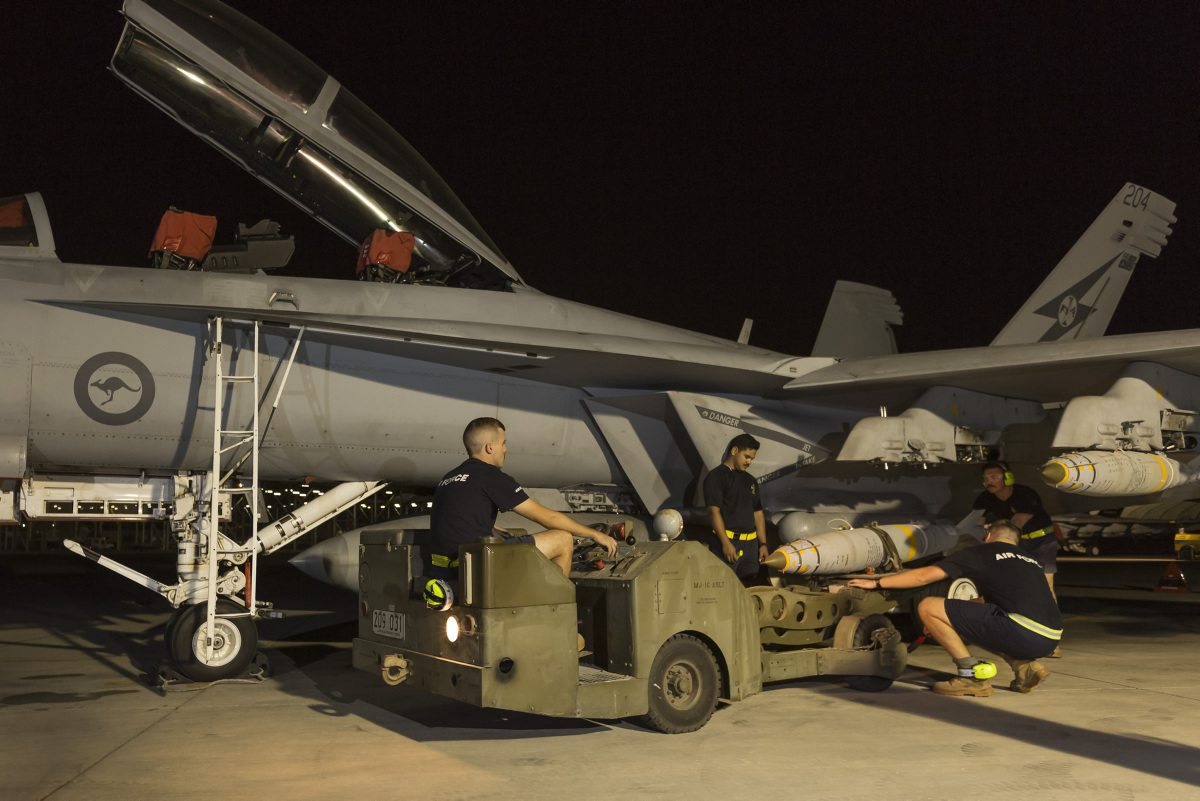
Royal Australian Air Force armament technicians from the Air Task Group, load a GBU-38V4 500 pound bomb to an F/A-18F Super Hornet aircraft on the flightline at the main air operating base in the Middle East Region. *** Local Caption *** The Air Task Group (ATG) of Operation OKRA, is operating at the request of the Iraqi Government within a US-led international coalition assembled to disrupt and degrade Daesh operations in the Middle East Region (MER). The ATG comprises six F/A-18F Super Hornet fighter aircraft, an E-7A Wedgetail airborne command and control aircraft, and a KC-30A Multi-Role Tanker Transport air-to-air refuelling aircraft. Additionally, the ATG has personnel working in the Combined Air and Space Operations Centre, and embedded with the Kingpin US tactical Command and Control Unit.
The ATG is directly supported by elements of Operation ACCORDION including the Theatre Communications Group, Air Mobility Task Group, and the Expeditionary Airbase Operations Unit, whose mission is to provide airbase and aviation operational support to sustain air operations in the MER. There are up to 300 personnel deployed at any one time to the Air Task Group, with an additional 100 personnel deployed in direct support of Operation OKRA. © Commonwealth of Australia, Department of Defence

Royal Australian Air Force maintenance personnel from the Air Task Group deployed at the main air operating base in the Middle East Region, display the newly approved light weight shirts to help manage working in the searing temperatures of the summer months. *** Local Caption *** The Air Task Group (ATG) of Operation OKRA, is operating at the request of the Iraqi Government within a US-led international coalition assembled to disrupt and degrade Daesh operations in the Middle East Region (MER). The ATG comprises six F/A-18F Super Hornet fighter aircraft, an E-7A Wedgetail airborne command and control aircraft, and a KC-30A Multi-Role Tanker Transport air-to-air refuelling aircraft. Additionally, the ATG has personnel working in the Combined Air and Space Operations Centre, and embedded with the Kingpin US tactical Command and Control Unit.
The ATG is directly supported by elements of Operation ACCORDION including the Theatre Communications Group, Air Mobility Task Group, and the Expeditionary Airbase Operations Unit, whose mission is to provide airbase and aviation operational support to sustain air operations in the MER. There are up to 300 personnel deployed at any one time to the Air Task Group, with an additional 100 personnel deployed in direct support of Operation OKRA. © Commonwealth of Australia, Department of Defence
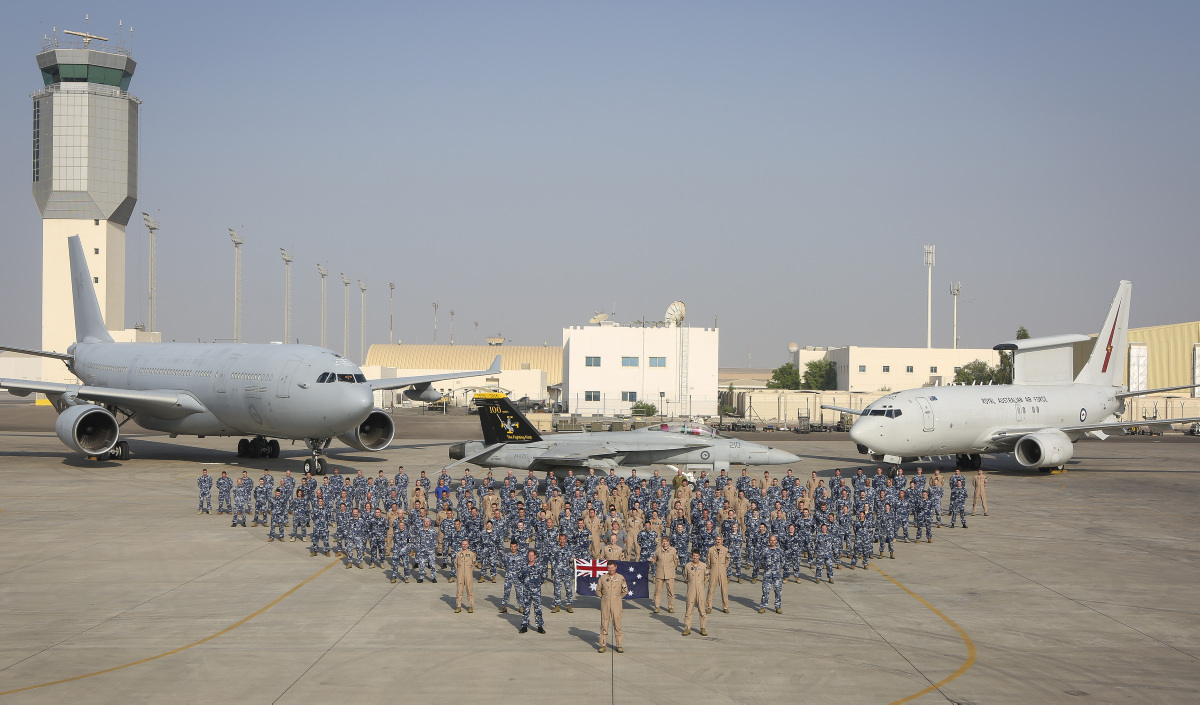
Australian Defence Force personnel based at Australia’s main air operating base in the Middle East Region with a range of Australian aircraft. *** Local Caption *** The Air Task Group (ATG) is deployed on Operation OKRA and is operating at the request of the Iraqi Government with a US-led Global Coalition assembled to disrupt and degrade Daesh operations in the Middle East Region (MER). The ATG comprises six RAAF F/A-18F Super Hornet fighter aircraft, an E-7A Wedgetail airborne command and control aircraft, and a KC-30A Multi-Role Tanker Transport aircraft. Additionally, the ATG has personnel working in the Combined Air and Space Operations Centre, and embedded with the Kingpin US tactical Command and Control Unit.
The ATG is directly supported by elements of Operation ACCORDION including the Theatre Communications Group, Air Mobility Task Group, and the Expeditionary Airbase Operations Unit. There are up to 300 Australian Defence Force personnel deployed, at any one time, as part of, or in direct support of the ATG. © Commonwealth of Australia, Department of Defence

The KC-30A Multi Role Tanker Transport and the E-7A Wedgetail fly in close formation during an air-to-air refuelling serial as part of Operation OKRA while a Royal Australian Air Force F/A-18F Super Hornet formates on the pair. *** Local Caption *** The Air Task Group (ATG) is deployed on Operation OKRA and is operating at the request of the Iraqi Government with a US-led Global Coalition assembled to disrupt and degrade Daesh operations in the Middle East Region (MER). The ATG comprises six RAAF F/A-18F Super Hornet fighter aircraft, an E-7A Wedgetail airborne command and control aircraft, and a KC-30A Multi-Role Tanker Transport aircraft. Additionally, the ATG has personnel working in the Combined Air and Space Operations Centre, and embedded with the Kingpin US tactical command and control unit.
The ATG is directly supported by elements of Operation ACCORDION including the Theatre Communications Group, Air Mobility Task Group, and the Expeditionary Airbase Operations Unit. There are up to 300 Australian Defence Force personnel deployed, at any one time, as part of, or in direct support of the ATG. © Commonwealth of Australia, Department of Defence
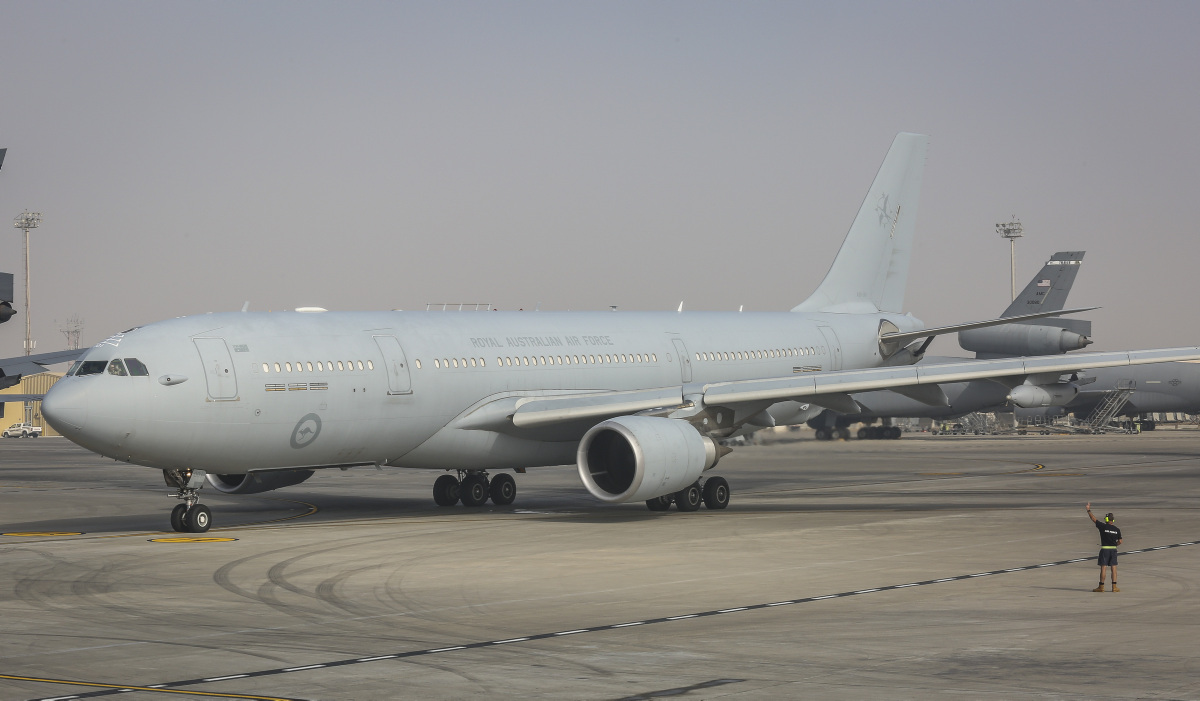
A KC-30A Multi Role Tanker Transport is given the all clear by ground staff for a mission in support of Operation OKRA on Christmas Day. *** Local Caption *** The Air Task Group began Christmas day in the fog with a bacon and egg breakfast at the main air operating base in the Middle East Region. For our aircraft and aircrew deployed, operations continue with aircraft providing support to the Iraqi ground forces.
The Air Task Group (ATG) is deployed on Operation OKRA. The ATG is operating at the request of the Iraqi Government within a US-led Global Coalition assembled to degrade and defeat Daesh. The ATG comprises six RAAF F/A-18F Super Hornet fighter aircraft and a KC-30A Multi Role Tanker Transport aircraft. Additionally, the ATG has personnel working in the Combined Air and Space Operations Centre, and embedded with the Kingpin US tactical command and control unit.
On the 21 Dec 17, the Minister of Defence announced that the Strike element would return to Australia in late January. © Commonwealth of Australia, Department of Defence
